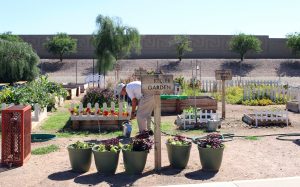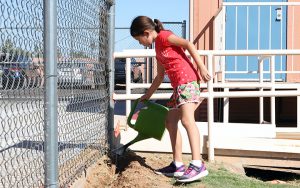- Slug: BC-CNS Farm to School, 730 words.
- 3 photos and captions below.
- Video here.
By Anikka Abbott
Cronkite News
MESA – On a regular school night, the Abajian family gathers to prepare dinner. Deborah Abajian cuts cucumbers while her husband, Gabriel, teaches their 6-year-old daughter how to peel carrots.
“You always want to go away from your body,” he tells Delainey, tucked into a black apron, her hair pulled safely back into a ponytail.
A first-grader at Mesa’s Keller Elementary, Delainey just learned about multicolored carrots in her school’s garden club – one of hundreds of programs across the state that aim to fill a nutrition gap in underserved communities by teaching kids how to grow healthy foods.
The idea is the students might then bring home what they learn about health and nutrition.
“It’s a really, really fun activity for me,” Delainey said. “I just love gardening so much.”
The Mesa program is part of a larger national effort called Farm to School, which promotes better health in children through school gardens, education related to agriculture and food, and encouraging the purchase of local foods for use in school cafeterias.
Some 42,000 U.S. schools take part, including more than 500 in Arizona. Most of the gardens are in communities where more than 50% of students receive free or reduced-cost lunch.
“It’s a very impactful way to get kids excited about eating healthy food,” said Ashley Schimke, who oversees the state program at the Arizona Department of Education. “We think it’s really important not only for their physical development but also for their mental and psychological growth over the years.”
Keller Elementary is a dual-language school that is nearly 70% Latino; about 80% of the students receive free or reduced-price lunches.
Lynette Kaspor, a former physical education teacher at the school, and coworker Joe Wise started the school’s garden in 2007. Wise planted a row of sweet peas along a fence line, and the kids became interested in watching them grow.
Today, 30 kids participate in the weekly after-school program. Eleven raised beds filled with such vegetables as kale and zucchini sit near the playground, along with a hummingbird garden.
Kaspor, now retired, Wise and three other volunteers teach the students how to properly plant seeds, protect against pests and weeds, and pick vegetables. They also teach the students the science and nutrition behind what they’re growing.
The goal, Kaspor said, is “to make sure that they’re healthy during the day, that they have plenty of energy to get through the day with their coursework.”
Obesity and weight-related health issues are on the rise across the nation, and problems such as diabetes hit minorities, including Latinos, especially hard.
“What is really concerning and really sad is that we are starting to see diabetes in younger individuals in Latino communities at higher or disproportionate rates compared to other communities,” said Sonia Vega-López, an associate professor in nutrition at Arizona State University.
Vega-López noted that many health problems are made worse by living in food deserts, or places that lack access to nutritious food. These include rural communities without grocery stores and urban communities with access only to stores with limited food options.
Lesser-known “food swamps” – places with only unhealthy food options, such as urban areas that have fast-food restaurants but no grocery stores – exacerbate the issue.
“Many neighborhoods that have a greater concentration of Latinos tend to fall in those categories,” Vega-López said. “Particularly food swamps over food deserts, but really both.”
School gardens can help fill the gaps. At Keller, the students take home the vegetables they grow. Kaspor said many parents have begun asking for recipes or tips on starting their own gardens.
Because of Delainey’s enthusiasm, the Abajians created a garden in a small planter at home.
“She’s come home telling me all sorts of vegetables and fruits that not only can we grow, but we need to purchase if we don’t grow them ourselves,” Delainey’s mother said.
Kaspor hopes to expand the club at Keller. She already has held a vegetable market for parents at parent-teacher conferences and plans to bring in a chef in coming weeks to teach the students how to cook some of their veggies.
“If I can get the word out that the kids are eating better, they’re taking home things to share with the parents, they’re cooking those things at home – the family is then eating better at home as well,” she said.
For more stories from Cronkite News, visit cronkitenews.azpbs.org.
^_=




